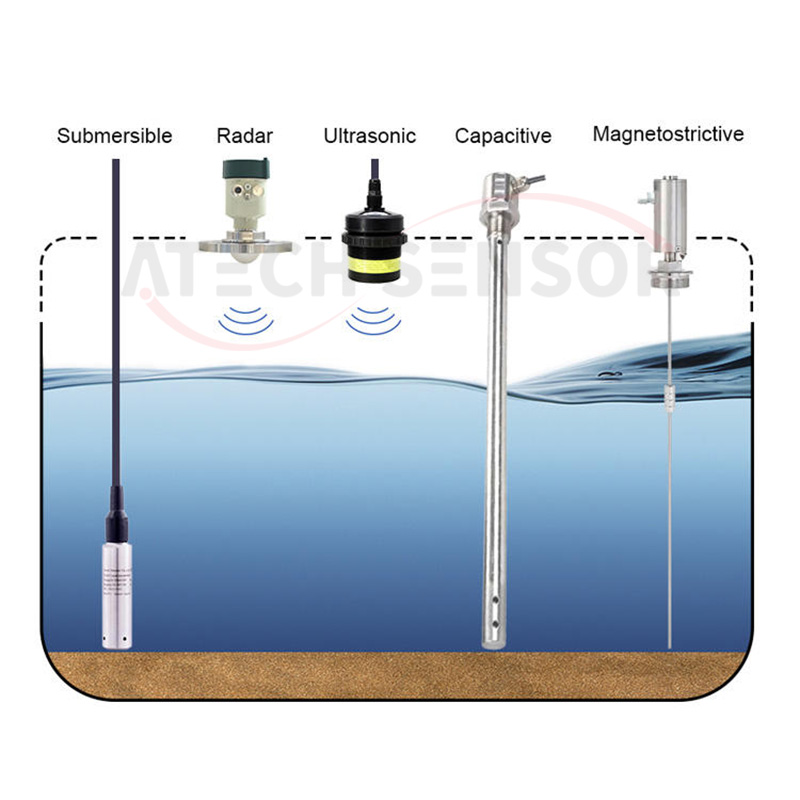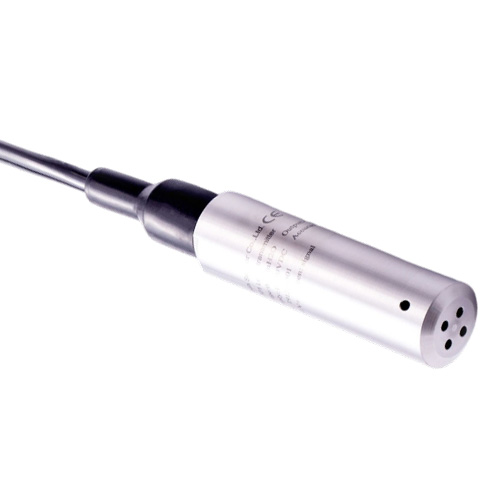1.How it works
Submersible level gauges operate based on the principle of hydrostatic pressure in physics. In a liquid medium, the pressure generated at a certain depth is due to the weight of the medium above the measurement point. This pressure is proportional to the density of the medium and the local acceleration due to gravity. This relationship can be expressed using the formula P = ρgh, where P represents pressure, ρ represents medium density, g represents the acceleration due to gravity, and h represents the depth of the measurement point.
Submersible level gauges contain sensitive elements, typically made of diffused silicon or ceramic materials, that exhibit a piezoresistive effect. When the gauge is immersed in the liquid being measured, pressure is applied to the surface of the sensitive element facing the liquid. This pressure is introduced into the sensor's positive pressure chamber through devices such as gas-conducting stainless steel. Simultaneously, the atmospheric pressure above the liquid surface is connected to the sensor's negative pressure chamber, offsetting the atmospheric pressure behind the sensor. The resulting pressure measured by the sensor is ρgh, the static pressure generated by the height of the liquid column.
The sensor converts this pressure signal into an electrical signal. After temperature compensation and linearity correction, it is converted into a standard electrical signal (such as 4-20mA or 1-5VDC) for output. Users can determine the liquid level based on the output electrical signal. Because the measurement principle of the submersible level gauge is based on the static pressure of the liquid, it is unaffected by foaming, sedimentation, or electrical characteristics of the measured medium, and has high accuracy and stability.

2.Installation Method
The installation method of the immersion level meter needs to be determined according to the specific application scenario and measurement requirements. The following are some common installation methods of immersion level meters:
2.1Installation in still water:
When installing a submersible level gauge in a static environment such as a deep well or pool, the gauge probe can be placed directly into the water. To protect the probe and ensure measurement accuracy, a steel pipe with an inner diameter of approximately 45 mm is typically fixed in the water. Several small holes are drilled at various heights in the pipe to allow water to flow freely. The submersible level gauge is then placed in the pipe and ready for use.
At the container opening, the cable (junction box) can be fixed using nylon straps or a tripod adjustable mounting bracket.
2.2Installation in flowing water or stirred liquids:
When measuring the level of flowing or agitated liquids, a steel pipe with an inner diameter of approximately 45 mm is also required. This pipe should be fixed on the side opposite the liquid flow direction and have several small holes drilled at different heights to allow for smooth water flow. The submersible level gauge is then placed into the pipe. This method ensures that the probe remains stable in the flowing liquid and accurately measures the liquid level.
The installation direction of the submersible level meter should be vertical, and the installation position should be away from the liquid inlet and outlet and the agitator to avoid the influence of liquid flow on the measurement.
2.3Other installation methods:
In addition to the two common installation methods mentioned above, submersible level gauges can also be flange mounted, bracket mounted, or threaded mounted. The choice of these installation methods usually depends on the specific installation environment and measurement requirements.
2.4Installation Notes
Grounding and shielding: The grounding terminal of the submersible level meter should be reliably grounded, and the power shielding wire should be connected to it to prevent electrical interference.
Cable protection: During installation, avoid excessive bending or pulling of the cable to avoid damage to the cable. Especially when the transmitter is installed on the side, the bending radius of the air guide cable should be greater than 10 cm.
Vibration protection: In applications with high vibration, steel wire can be wrapped around the transmitter for shock absorption to prevent the cable from being broken.
Probe protection: Since sludge, oil residue, and other materials are easily deposited on the bottom of the tank or tank, it is recommended to keep the measuring probe at a certain height from the bottom of the tank (tank) to prevent debris from clogging the probe. The pressure inlet of the submersible level gauge is equipped with an isolation diaphragm, which should be avoided from contact with foreign objects.
Wetting of permeable parts: Before installation, ensure that the permeable parts of the submersible level gauge are soaked in water for more than 2 hours to fully wet the permeable parts and avoid measurement errors.
Correct wiring: When connecting the circuit, follow the wiring method in the instruction manual to avoid wiring errors that may damage the circuit.

3.Troubleshooting and maintenance
Submersible level gauges may experience malfunctions over extended use, such as no display output, leaks in the float or pressure lead pipe, and other issues. These malfunctions may be caused by power supply issues, incorrect wiring, or poor sealing at component connections. Users can conduct preliminary troubleshooting based on the malfunction symptoms, such as checking the wiring and circuitry, and the sealing of component connections. If the problem persists, contact the manufacturer's professional technicians for troubleshooting and repair.
In addition, in order to maintain the stability and accuracy of the immersion level meter, users should also perform regular maintenance and inspections, such as probe desilting, cable protection, etc. These measures can extend the service life of the immersion level meter and ensure its measurement accuracy.

